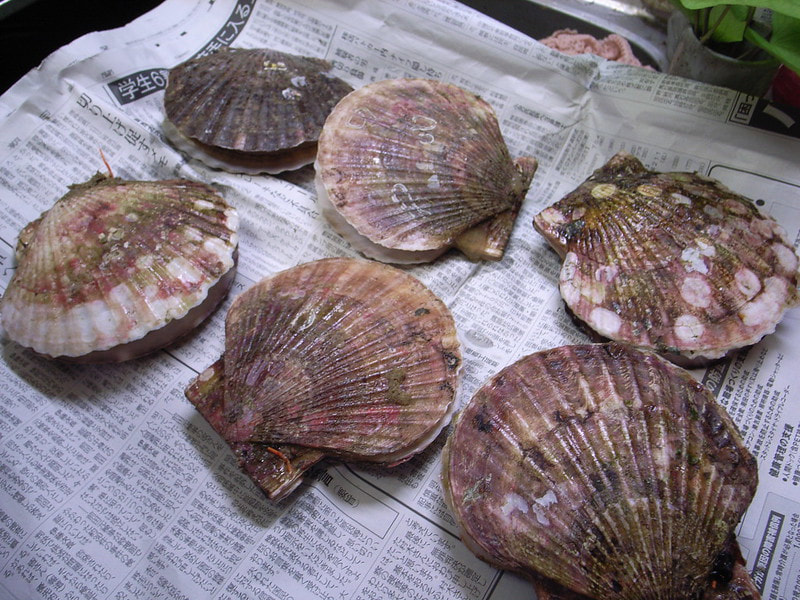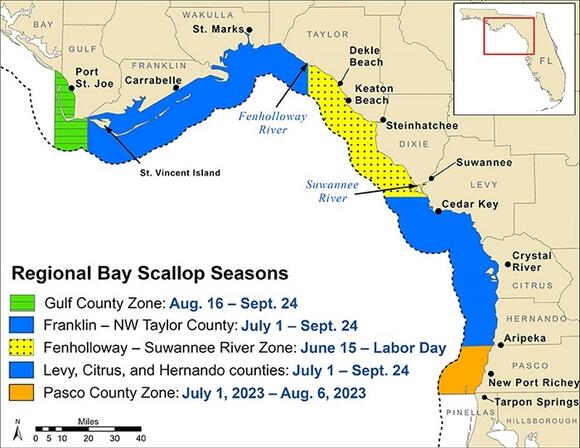|
Get ready fishermen and women, the Florida Fish and Wildlife Conservation Commission (FWC) has announced the official opening of scalloping season for the Fenholloway River and Suwannee River Zone starting this week — here's what you need to know before you cast your nets. The Fenholloway and Suwannee Zone season will run from June 15 through September 4, and includes all state waters in Dixie County, as well as a portion of Taylor County, the towns of Keaton Beach and Steinhatchee, and a small portion of Levy County. The daily bag limit from June 15-30 in this area is 1 gallon of whole bay scallops in the shell or 1 cup shucked bay scallop meat per person, with a maximum of 5 gallons whole or 2 pints (4 cups) shucked bay scallop meat per vessel. Starting July 1 through Labor Day in this area, and for the duration of the open season in other areas, regular bag and vessel limits will apply. Regular season limits are 2 gallons of whole bay scallops in the shell or 1 pint of bay scallop meat per person, with a maximum of 10 gallons of whole bay scallops in the shell or 1/2 gallon (4 pints) shucked bay scallop meat per vessel. Throughout the season and region-wide, vessel limits do not allow an individual to exceed their personal bag limit. Other 2023 season dates There are different regional bay scallop seasons, but the regulations do allow direct and continuous transit of legally harvested bay scallops through areas that are closed. When traveling, the FWC says that boaters may not stop their vessels in waters that are closed to harvest and must proceed directly to the dock or ramp to land their scallops in a closed area. The other bay scallop season dates as listed by the FWC are as follows:
Other regulations No commercial harvest for bay scallops is allowed in Florida. Scallops may be collected by hand or with a landing or dip net. Recreational harvesters need a Florida saltwater fishing license to harvest bay scallops unless they are:
Boater and scalloper safety The FWC asks that all participants be safe when diving for scallops, recommending the wearing of life jackets when underway, and to not drink when aboard your boat. If scalloping in open waters, divers should stay within 300 feet of a properly displayed divers-down flag or device, and within 100 feet of a properly displayed divers-down flag or device if on a river, inlet, or navigation channel. Boat operators traveling within 300 feet of a divers-down flag or device in open water or within 100 feet of one on a river, inlet, or navigational channel must slow their vessel to an idle speed. For more information regarding boating safety and scallop season regulations, visit MyFWC.com/Boating and click on “Boating Regulations” and then “Divers-down Warning Devices.” Stow it, don’t throw it The FWC also asks participants to please not discard of scallop shells in inshore waters commonly used for recreational activities, such as near boat ramps or in popular swimming areas like Crystal River. Piles of discarded scallop shells can create hazards for swimmers and damage seagrass habitats. Scallop shells can be discarded in a trash receptacle or in larger bodies of water where they are more likely to disperse. The FWC also recommends to stow your trash securely on your vessel so that it doesn’t blow overboard. A map of the regional bay scallop zones and their season dates can be seen below: Article by Rachael Volpe
0 Comments
Your comment will be posted after it is approved.
Leave a Reply. |
CATEGORIES |
|
|
Vertical Divider
|
Can't get enough?Uncover more of Florida through our channels below!
|
© COPYRIGHT 2015. ALL RIGHTS RESERVED.



 RSS Feed
RSS Feed